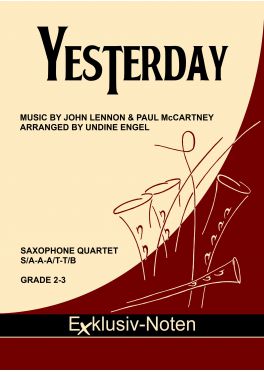Categories
Newsletter

This song is certainly not your typical arrangement fare, it’s world-famous and has been covered thousands of times. As such, for arrangements it’s usually avoided because of the risk that it has been heard too often. So why throw my hat into the ring?
While I never paid intense attention to the Beatles, my fellow three quartet members love this song. But there are always melodies that are so stripped-down to their core that they convey everything you need to and touch the soul. And yes: I count Yesterday among these ranks.
Contrary to most covers, the (melancholic) text is not the main attraction, instead the music and the chords convey everything that needs to be said.
This arrangement could be played in flexible instrumentations, even without a baritone saxophone. However, the SATB quartet is ideal; beginning in the 34th measure the tenor carries the melody, but is steadily “orbited” by the soprano. For a brief moment the melancholy is broken, only for both voices to lose themselves in it from anew. Or it invites you to reminisce on a moment in time that used to be a happy memory only for it now to be bittersweet. As always, it’s all subject to interpretation.
John Lennon and Paul McCartney wrote this song in 1964, they knew exactly how the melody would nest in its listeners’ ears worldwide. As such the song still remains immensely popular today and is enjoyed by music aficionados of all walks of life.
The first voice is definitely the main focus, while the remaining voices act as steady companions and emerge more clearly during the breaks or transitions. Because of how the harmonies hone in on our feelings, the question of major or minor key is a secondary one. Within this piece, there are no sudden loud moments, but instead the intensity of each instrument’s voice is highlighted. Clocking in at just over two minutes and yet volumes have been spoken.
This serves as a musical excursion into the past and what no longer is. At the end of the piece there is a major chord as if to say: Let go and look onwards or allow yourself to dwell in the happy memories of the past.
Included in delivery:
- transposed score
- Part 1:
- soprano
- alto
- soprano
- Part 2: alto
- Part 3:
- alto
- tenor
- alto
- Part 4:
- tenor
- baritone
- tenor
- Besetzung s/a-a-a/t-b/t
- Schwierigkeitsgrad 2-3
- Rudolph, the Red-Nosed Reindeer
- Saxophone quintet or quartet
s/a-a-a/t-(t)-b
arr. by Bernd Frank...
Read more - I'm Dreaming of a White Christmas
- Saxophone quartet s/aatb
arr. by Bernd Frank
comp. by Irving Berlin...
Read more - I'm Dreaming of a White Christmas
- Saxophone quintet s/a-a-a/t-t-b
arr. by Bernd Frank
comp. by Irving...
Read more - Feliz Navidad
- Saxophone Quartet s/aatb
arr. Undine Engel & Bernd Frank
comp....
Read more - Jingle Bells Samba
- Saxophone quartet s/aatb
comp. by James Lord Pierpont
arr. by Heiko...
Read more









